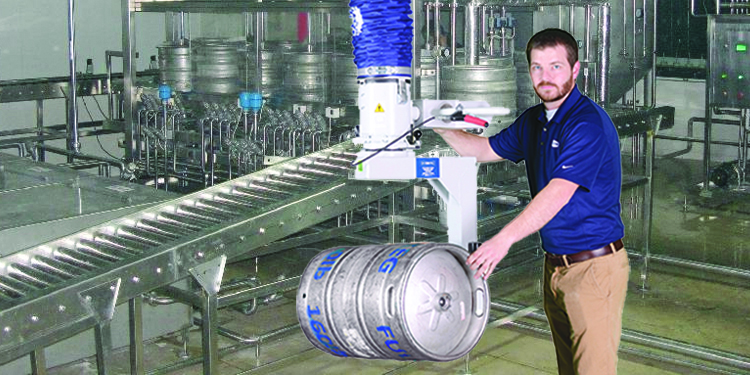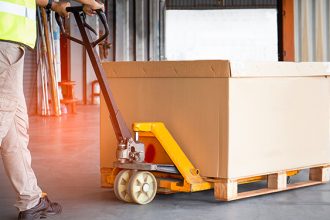Handle Unusual, Hard-To-Grip Loads With Ergonomic Vacuum Lifters

Not every load has the uniform shape, sturdy construction, durable surface, flat sides, or continuous rigidity required for it to be successfully lifted by an ergonomic workstation crane and hoist outfitted with a mechanical lifting device such as a clamp, hook, sling, or gripper. For these types of items, an ergonomic vacuum lifter—typically customized to the unique application—might be the best option.
A vacuum lifter features one or more suction cups (also called grippers) connected to a unit (either a pump, blower, or ejectors) that generates a vacuum by evacuating air when activated by the operator. This creates negative pressure within the gripper compared to the ambient air pressure, allowing the lifter to attach to and pick up the load. The load is then raised and lowered with either a tube system or a chain or wire hoist. After guiding the load to its destination, the operator directs the system to vent, allowing the cup to fill with air and releasing its grip on the load.
Onboard controls allow the operator to easily guide and manipulate the load as required, while the system’s inherent dexterity allows for incremental adjustments in placement with very little effort on the part of the operator. Because the lifters can be designed to handle capacities up to 1,500 pounds, they eliminate the risk of an operator sustaining an injury due to repetitive or strenuous motions such as pulling, pushing, lifting, carrying, holding, or reaching to maneuver the workpiece.
To determine the number of suction cups needed to attach to the load—and the amount of vacuum pressure required to connect to and securely hold the load while it is suspended—the best practice is to work with a vacuum lift supplier. Their design and engineering team will evaluate a variety of factors when assessing the load and lifting application, then make a recommendation about the optimal solution. Load characteristics to be considered include:
- Weight – How heavy is the load, and is the weight evenly distributed or not?
- Shape/Form – Is the load a flat sheet of material, or a three-dimensional object? If three-dimensional, is the load a cube, cylindrical or other shape? Is it uniform in shape or asymmetrical? Are there any flat sides?
- Size – If uniform, what are the overall dimensions of the load? If asymmetrical, what are the smallest and largest dimensions? If one or more flat sides exist, how many are there, what are their dimensions, and are they adjacent to each other?
- Material – What is the load made of, and what are the material’s properties? Is it porous and permeable (cardboard boxes, bags, wooden boards) or smooth and airtight (glass sheets, metal plates)? Can the load withstand a certain degree of deflection, or will any amount of bending damage the load? Does it have a surface or finish that can be easily damaged?
- Process – What is the intended movement or required maneuver for the load once connected to the vacuum lifter device? Horizontal travel from point A to point B? A swivel up to 90 degrees? A 180-degree flip from front to back?
Based on the answers to these questions, the appropriate vacuum lifter can be specified and designed to handle the unique load. For example:
- Drum lifters might incorporate a vacuum lifter that connects to the top, flat surface of the cylinder, while integrated, curved mechanical grippers gently clamp onto the sides for additional stability in transport.
- Cardboard boxes that are held closed with slots and tabs instead of by adhesive tape can be stabilized with a vacuum gripper that attaches to both the top and one or more sides.
- Flat sheets of materials that cannot deflect beyond a certain point without being damaged can be handled with vacuum grippers designed for multiple points of contact that stabilize the load once it is lifted.
In addition to safely and securely attaching to a load, as well as eliminating effort associated with manually maneuvering, a properly designed ergonomic vacuum lifter can increase operational productivity by allowing more parts to be placed and removed faster for an overall boost in output. Because of this, it’s worthwhile to have all loads assessed for their ability to be lifted with an ergonomic device. Although some operations believe an object is too unusual or hard to grip, a safe lifting solution can usually be found.
Looking for more ways to improve ergonomics in your manual material handling operation? Download the free publication, “Ergonomic Guidelines for Manual Material Handling,” published by the members of Ergonomic Assist Systems & Equipment (EASE).



